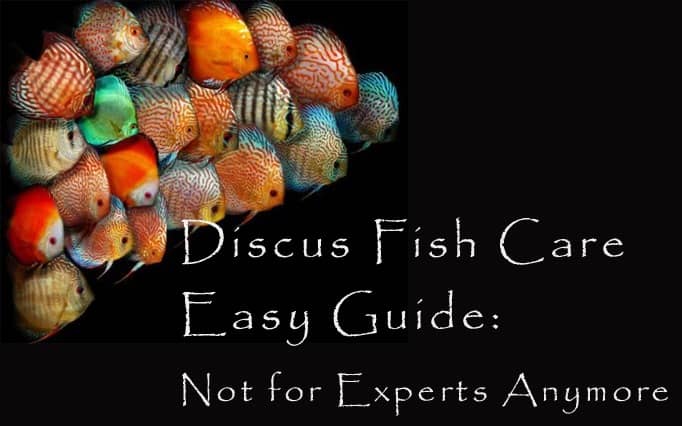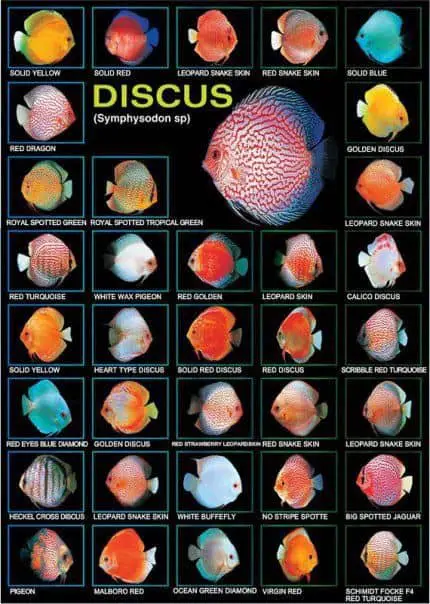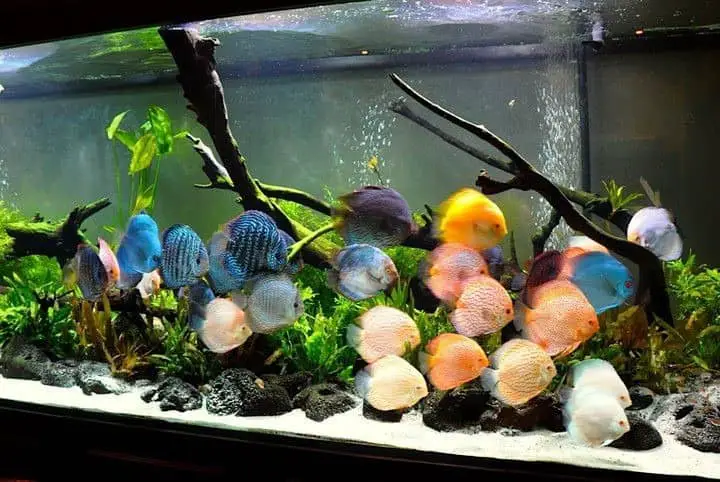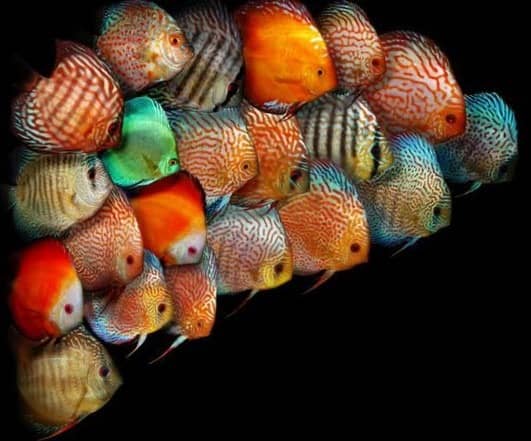Discus fish is among the grandest freshwater fish suitable for the home aquarium. They are mostly known as the “King of the Aquarium” for their magnificence and royal colors. Discus fish are fascinating fish to enjoy for aquarium keepers, and they have gained popularity over time as they are very colorful due to their specific attractiveness. They are Peaceful but larger than other tropical fish, these fish illuminate the space where they are. In this post, you can learn about discus fish care.

They belong to the Cichlidae family. Symphysodon is a family of cichlids native to the Amazon river basin in South America, colloquially known as discus. Owing to its unique shape, behavior, patterns, and bright colors, discus becomes popular as a freshwater aquarium fish, and its aquaculture is a major in several Asian countries.
Discus fish care
Jump To
- 1 Discus fish care
- 2 Why Are Discus Fish so Expensive and Rewarding
- 3 Discus Fish life span
- 4 Fish Size
- 5 Discus Fish Appearance, colors
- 6 Discus Fish Types
- 7
- 8 Typical Behavior
- 9 Discus Fish Tank Requirements
- 10 Discus Tank Mates
- 11 Discus Fish Food
- 12 Breeding Discus Fish
- 13 How Do You Keep Discus Fish Happy
- 14 Which size if Discus Fish to buy
- 15 Discus fish cost
- 16 Diseases
At least three species described while the validity of some assigned scientific names continues to be debated. Wild-caught discus can be difficult to keep because of their complex water chemistry and dietary requirements, but most discus sold today are bred in captivity and are much easier to maintain.
Even though Discus fish are intimidating, they aren’t as overwhelming as they may seem, and the enjoyment gained from their stunning appearance makes them more than valued it. They will create your larger tank, something great to show off.
Make sure to keep the proper condition, and you’ll be rewarded with attractive colorful fish. However, due to a wide range of reasons, they are not suitable for beginners. Multiple color variations are available via selective breeding, and much more continues to be created.
Remarkably pretty difficult to care for, but so rewarding when properly kept, Discus fish are the crowning glory of those who own them. This fish’s beautiful colors change based on stress levels, age, nutrition, and the conditions of the tank. They are prized for their bright look and shoaling behavior in the aquarium trade.
Why Are Discus Fish so Expensive and Rewarding
Except for their attractive appearance among other advantages of maintaining discus fish, there are other drawbacks and the most notable among them is the price. Discus fish are also more costly to purchase as compared with other aquarium fish on the market. There are many explanations for why discus fish are expensive. Below are some of the best reasons for that,
Demand
A simple supply and demand situation is another reason discus fish are so costly. For example, there aren’t many breeders in the USA. For this cause, they are not generating demand for particular varieties anywhere near. Another choice was imported discus fish, but they come with lots of costly and risky to manage. The trans-shipper must house them, manage any issues, bear any losses due to carrier negligence and give the purchaser some form of guarantee. These factors raise the cost of the imported discussion even further.
Apart from the lower supply, people like the fish from the discus and so demand is also high. Shops will charge extra for this purpose, and customers will pay for it. There’s also a huge demand for these fish as they’re getting more and more popular for their fantastic looks.
They need more time to grow
There is a relatively more period involved in growing discus from fry to adult. Adults of better quality are also much more, and it was presumably by a method of culling. So essentially the cost of discus fishing comes down to how much time breeders put in the birds. Time is money, and you’ll need plenty of time to collect good high-quality discus.
Compared to other tropical fish, they need warmer temperatures.
This is a major expense to those discus fishery keepers in the colder climate. This is why imported Asian discus is much cheaper as they leave the breeding establishments and discus fish care. Growing them out there, it cost less. Retailing for discus fish is also costly because the seller needs to make enough to pay for the losses and sit in business.
Brand of Breeding
Discus fish have brands of the name, but it depends on how the fish was born. Some people favor a certain brand of the discus fish breeder and will pay any price as long as it comes from the manufacturer. This will be benefited greatly by the breeder, and a high price will be set, which will cost the discus.
More labor cost
Discus fish are so costly because it needs some of the most labor-intensive fish-keeping methods used for breeding and conserving them. There is a lot of work to hold and breed the fish to create large and better varieties of the best colors. Breeding discus takes more preparation, very good water quality, less fish in the aquarium, and the more costly larger ones are possibly around a year old.
They would have to be treated in very good conditions to get them to grow and fed good quality food. All these difficult labor-intensive activities make discus fish more pricey.
Quality Food and Water
Discus fish care and food are relatively costly, regardless of whether you go for homemade food or off-the-shelf foods. Making your Beef heart or seafood mix is also not cheap. They also have very stringent water requirements, and most breeders have to work very hard to fulfill these requirements. These rigorous demands make them very costly.
Discus Fish life span
Discus lives with proper care in home aquariums have an average of 6 to 10 years. But some of them can live up to fifteen years. As the age of Discus fish, gravity still influences their appearance even in water and takes its toll on aging. Their dorsal and tail fine start to drop, and their skin becomes wrinkled and looks old. Their color will disappear in the later stages of life, their hunger will decrease, and they’ll become thin.
Discus fish at their peak appearance and breeding growth between both the ages of 2 and 4 years. They are most colorful at this age, showing erect fins, and the skin is wrinkle-free and smooth. This is also because they’re more likely to breed successfully and grow a brood of fry together. While females will start laying eggs at a time of 1 year, males lag and are most fertile and best at parenting when they reach two years.
Death for older Discus fish usually happens overnight and is found in the morning.
Fish Size
Discus usually reaches lengths of up to 12.3–15.2 cm (4.8–6.0 in), but captives are believed to exceed 23 cm (9 inches). In general, adults weigh 150–250 g (5.3–8.8 oz). There is no obvious sexual dimorphism for this species, but males can reach a larger size than females.
Discus Fish Appearance, colors
The Discus fish in any aquarium is perhaps the most attractive and elegant. Its body shape on the sides is very compressed. It has a disc-shaped appearance, and its fins are beautiful and big. It is an iridescent plant, with stripes, and vertical bands of various colors. Those are white, red, blue, blue and green, brown, yellow, orange, and black. However, there are no significant variations between genera.
Discus Fish Types
There are many different varieties in Discus fish. It’s worthy of your attention to create a shoal that has the colors you want best. The various Discus forms are based on their coloration.
A checkerboard Discus fish, which has a mottled turquoise splashed over a deep red base, is one of the most popular types. Varieties like Red Alenquer and Giant Flora Discus boast light blues and deep reds, while Albino Platinum Discus are all white with almost glowing red eyes.

Typical Behavior
They are one of the biggest and brightest fishes in most tanks. Discus fish are schooling fish, and a wall of patterns may be demonstrated around the tank in large groups. This information is important in discus fish care Discus fish have very peaceful behavior. They avoid violence via escape and intimidation. Like all cichlids, there may be some competitiveness in the shoal, and a pecking order may be formed.
That implies the smaller fish will need to be controlled to ensure they can feed. They prefer to remain in the mid-levels. However, they can move to the top and dip to the bottom to forage. Therefore, they can quickly conquer all tank stages. They like to swim freely but need the choice to be close to covering, such as large driftwood or aquarium plants.
Discus Fish Tank Requirements
Habits of Discuss
Discus is present in lowland Amazon River basin floodplain lakes and flooded forests, and some of its tributaries, including the Rio Negro. The seasonal flooding causes these areas to undergo drastic increases in water levels. Discus appears to gather near fallen trees along the shore, known as “galhadas.”They prefer calm water and are seldom found in places where the current or wave action is high.
Tank Size for Discus fish
Tank size in impotent in discus fish care. Since these fish need to be at least 5 in school, a 50-gallon tank is the minimum aquarium they can survive in. They enjoy big tanks, and upwards of 100 gallons means less drastic changes in water conditions can occur, and they will have the space they want. One Discus fish per 7 gallons is ideal.
Discus (Fish) Tank Conditions
These fish need temperatures 82-88 ° F higher than most fish. Holding this warmer temperature can minimize the risk of sickness and death, it can be preserved using a good quality heater. Amazonian water is smooth and mildly acidic, with a pH between 6 and 7. Check the pH and temperature under which they were raised before buying your fish to avoid drastic changes that could be dangerous.
You need to de-chlorinate the water in your tank and treat it with formulations that neutralize your water from the tap. The flow should be slow. This can be disrupted by using a spraying bar or by using sand or ornaments. Vertical wood can also be used to stop the flow of water. Make sure that these kinds of wood pieces can’t harm the Discus side when it swims by.
They need soft to moderate sediment as they often look for food on the substratum and can be harmed by larger fragments as they forage. Plants such as the Amazon Sword Plant or Dwarf Hairgrass are easy to add to your tank and provide your fish with oxygen. Plants often serve as a drain for nutrients, meaning decreases in the quality of water are more uncommon. This information is important in discus fish care.
Ideal temperature and pH for fish with Discus
Discus like warm, acidic, and soft water. So it is better to keep the pH between 6.0 and 7.0, between 1 ° and 4 ° dKH (18 to 70 ppm) in hardness. The temperature should be maintained between 82 ° and 86 ° F, because although wild Heckel discus prefers water close to 90 ° F.
| Parameter | Condition |
|---|---|
| pH | 6.0 -7.0 |
| Hardness | 18 – 70 ppm |
| Temperature | 82 ° – 86 ° F |
Water preparation
You may use an Aquarium Heater to keep the water temperature right. Although captive-bred discus can be kept in dechlorinated tap water, the best conditions will be given by reverse osmosis or de-ionized water supplemented with Water Renewal. When buying discus, often inquire about the chemistry of water in which they were grown.
Discus Really Need Daily Water Changes
While all tropical fish aquariums need daily changes in water, discus aquariums need frequent changes in water for a specific needs. Therefore you can change the aquarium water of your discus at least once a week. Some people change the water of their aquarium 2 or
3 times a week by 20 % to 25%.
Discus Fish tank filter system
Discus requires excellent water quality, and the use of an Aquarium Water Changer or Siphon Vacuum Gravel Cleaner is strongly recommended for weekly water changes of 10 to 25 percent. Until refilling your tank do not forget to treat the tap water with Aqueon Water Conditioner.
Filtering is particularly essential for maintaining a discus-fish fish tank. Discus fish tend not to have filters with a high turnover rate; instead, they want a filter with a turnover of 1 time per hour. They prefer calm water to fast-flowing waters, too.
A significant thing to remember is that discus fish can create a great deal more waste than other species. We must not underestimate the worth of a good filtration device. Another thing to remember is that the dirt stirred up and messed with by the discus fish will cause pollution water too. This information is important in discus fish care

Discus Tank Mates
Discus are typically shy fish kind. But this can be ended up helping by neighboring them with a few other fish. These fish are recognized as dither fish, and they are not in danger. Fish coming from the same warm Amazon waters are a good starting step. Moreover, shoaling Tetras looks wonderful. There are several fish types to a neighbor with discus fish. That includes Tetras, Rummy-nose, Neon Tetras, and Ember Tetras. They are elegant and more convenient to care.
Marbled or Neon Hatchet fish are also good fish to match with since hatchet fish occupies the tank’s highest level. Therefore you should ensure the lid is properly fit. Other great fish types of pairing with discus fish are Bolivian Rams, Gouramis, and Pencil fish.
Furthermore, Corydoras will pair with these Fish brilliantly, but they also need colder waters. Sterbai Cory Catfish is the right combination of catfish to have, as they live in warmer waters as they occupy a lower tank level, and are pretty calm.
Also, they can live in Coexistence with some of the larger shrimp and snail species but ensure that they’re not little enough to be bitten or harmed.
These fish cannot be mixed with aggressive fish, and some fish attempt to eat the Discus’ mucus coat which hurts them. Angelfish is often no trouble, while other times they harass them and out-compete them for small food supplies. However, Several kinds of fish have different types of temperaments. Therefore, you should carefully consider about hold different Fish types together.
Discus Fish Food
What do Discus fish eat?
Food is important in discus fish care. Discus is omnivores, so in the wild, they eat mostly green plants such as algae or fallen fruit. A part of their food also consists of arthropods, such as insects or crustaceans. Moreover, it consists of invertebrates, such as amphipods and copepods.
Best food and diet
They must be provided with a range of foods for better coloring. Various types of flake foods such as spirulina and tropical fish flakes, along with algae or shrimp pellets, can make up the vegetable portion of their diet. Live foods such as mosquito larvae, brine shrimps, and blood worms are good for them and can inspire bright colors to appear. While not normal, the heart of beef is typically fed and does not harm.
Feeding Discus
Discuss will need to feed every day, in a 3-5 minute time, and just what they eat. All excess food should be cleaned up after 5 minutes, as extra food can lead to health problems or poor water quality. As they have a pecking order, you should also be watching your fish. Make sure they all feed and are not distracted by larger tank mates. If that occurs regularly, the feed can be placed on either side of the tank.
Breeding Discus Fish

Requirements for Breeding Discus
Discus fish are known as one of the most attractive and colorful freshwater aquarium fish species, and they can be a pleasure to breed. Fish breeding can be a difficulty, but Discus breeding is a tough achievement.
However, they are very hard to breed; this also makes them very satisfying. They have very specific breeding criteria, and all of the previously described parameters (in the tank setup section) must be managed perfectly.
Discus Fish Breeding pair selection
Some discus strains may appear to show different patterns on both male and female fish, but this is not guaranteed. Females typically mate at around age 9, while males usually mate at age 13. Discus Fish (Symphysodon) tend to select their mates, aquarists who plan to breed Discus usually buy multiple specimens (5-10) at a young age. A guaranteed matted breeding pair, however, may be a good idea because a pair of Discus normally mates for life.
Breeding Behavior and Pairing
The male discus fish show aggressive behavior, typically chasing other fish away from the female discus or the area they are situated in. The male discus using aggressive behavior to assert the female as a mate and to prevent any possible mate from approaching the pair.
Spawning and taking care of the fry
It is best to use a spawning cone, which provides them with the perfect place to lay their eggs, and then you can put a wire tube over the eggs to stop them from becoming eaten. Then some breeders split the female as she is more likely to cannibalize her fry, and the male is going to rear the fry alone. The fry hatch after three days and they’ll be independent swimmers in another three days, feeding on the mucus created by their parents.
How Do You Keep Discus Fish Happy
The best way to keep your discus happy is by raising the temperature of the reservoir. We strongly suggest 85-86 ° F. The explanation is that we normally keep their waters at these temperatures from the discus farms, and when we attempt to impose them to cool down, this becomes a source of discomfort.
Which size if Discus Fish to buy
It basically, depends on the size of your tank, as example, Recommended measures for a tank 40 “x 20” x 20 for The two fish should be at least 14 cm long and similar in size. moreover, most times A 2 ½ inch discus fish is only three months old when they are shipped to customers.
Discus fish cost
High-quality discus ranges from $18 up to $150 in price. When buying discus fish for under $18, you need to be careful. Low-quality Discus fish are typically very small.
Diseases
Anorexia, eye cloudiness, ascites, excessive body mucus, frayed dorsal fin and tail rot, and discus fish suffered from mortality. They underwent clinical, postmortem, disease, bacterial and mycotic tests to explain the mortality causative agents.
Some specific external and internal diseases in a Discus fish include Rapid Breathing, Fungal Infections (External), Parasitic Anchor Worms (External), Discus Plague (External), Cloudy Eye Infection (External), Columnaris Disease (External or Internal), Fish Tuberculosis (Internal), Dropsy and Popeye (Internal), Hexamitiasis (Internal), Tapeworms (Internal). This information is important in discus fish care
Also, see our guide about Discus fish

